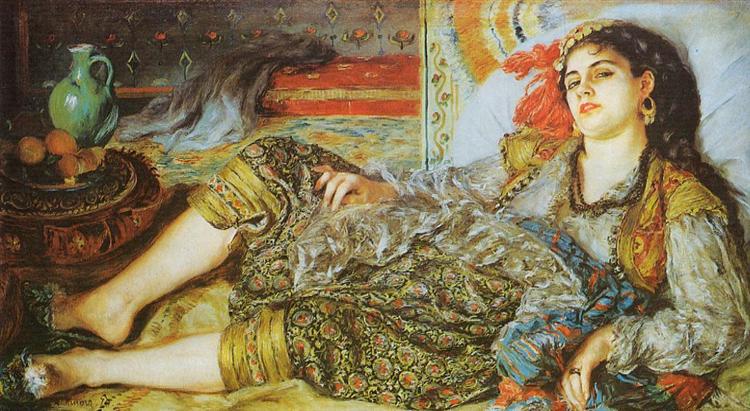Beskrivelse
Pierre-Auguste Renoir's Odalisque (An Algerian Woman), painted in 1870, stands as a fascinating example of the exploration of the female body and sensuality typical of 19th-century art. Reflecting Renoir's distinctive style, this painting fits into the broader context of Orientalist art, where European artists, drawn to the idea of the exotic, sought to capture the essence of cultures alien to their own.
In this composition, Renoir presents a reclining woman, caught in an atmosphere of intimacy and elongation. The way her figure is placed against a soft, luminous background demonstrates the artist's mastery in the representation of the human body, where each curve and fold is modeled with a technique that highlights the vitality of the skin. The woman, whose skin is treated with a wide palette of tones, from warm peaches to intense bronzes, seems to emanate an inner light that contrasts with the subtle shadows that embrace her, a technique that Renoir often used to convey the three-dimensionality and sensuality of the subject.
Renoir, through his conscious use of colour, creates a dreamlike atmosphere in which the viewer is drawn towards the central figure. The sheets, a rich navy blue, accentuate the richness of the scene and the implicit luxury of the room. This use of colour not only serves to define the texture and depth of the elements in the painting, but also invokes a sense of comfort and opulence in the woman’s surroundings, suggestive of a private and exclusive space. The background is composed of softer tones that allow the main figure to shine with undeniable prominence, making every aspect of the work reinforce the theme of sensuality and aesthetic pleasure.
The figure of the odalisque is sensitive to the orientalist context in which it is framed. These portraits of exotic women in dreamlike landscapes responded to a European curiosity about the cultures of North Africa and the Middle East. This interest was not merely superficial; her representation often sought a dialogue with perceptions of femininity, mystery and the forbidden. The odalisque here is not just a mere object of desire, but her expression and posture invite a deeper contemplation of the female condition at that time.
An interesting aspect of "Odalisque" is the way in which Renoir, throughout his career, often challenged academic norms of representation. This work is a clear example of his evolution towards a more personal and free form of expression. Rather than adhering to the rigid conventions of his time, Renoir infuses his work with a vibrant energy and sensual dynamism that speaks to both desire and the joy of living.
The influence of Impressionist painting is evident in the way he captures light and movement, as well as in the undulation of the fabric and subtle changes in colour. In speaking out in this work, Renoir not only offers us a vision of the aesthetics of the female body, but also sets up a study of light and surface, a visual dialogue that invites admiration and reflection.
"Odalisque (An Algerian Woman)" becomes both a symbol of the management of the exotic and the sensual that later curatorships could explore, while also reflecting Renoir's singular ability to transform the simplicity of the motif into a rich meditation on beauty and form. The work, therefore, is not only a portrait, but a manifestation of a time and a culture, which continues to captivate the modern viewer with its complexity and colorful brilliance.
KUADROS ©, a famous painting on your wall.
Hand-made oil painting reproductions, with the quality of professional artists and the distinctive seal of KUADROS ©.
Painting reproduction service with satisfaction guarantee. If you are not completely satisfied with the replica of your painting, we will refund 100% of your money.

